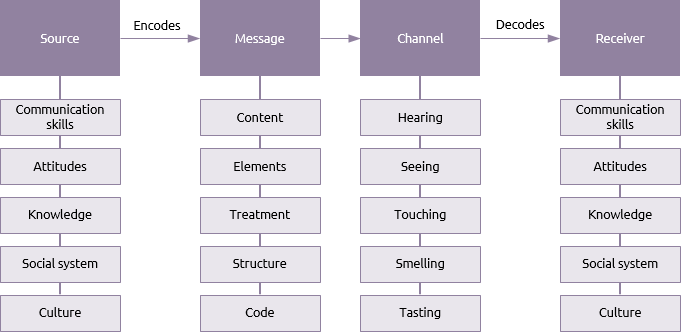David Berlo set out his theory of communication in 19601. It is also known as the SMCR model because of its four components: source, message, channel and receiver.

- Source
-
All communications have a source. This may be an individual, group or company. It is the source’s job to ‘encode’ the message that needs to be communicated. The way it does this will be affected by several attributes such as its communications skills; its attitude towards its audience; its knowledge of the content of the message; its social background and culture.
- Message
-
The source must encode the message to ensure that is contains the right content. In this case ‘content’ means everything that is communicated, intentionally and unintentionally. The elements of the communication could, for example, include the speech, body language and slides used in combination during a presentation. The treatment of the communication could be grave or light hearted, formal or informal and must be consistent with how the source wants the receiver to interpret the message.
-
All but the simplest of messages need to be structured so that multiple layers of the message are conveyed in a logical and cumulative way. They also need to be coded appropriately by, to use an obvious example, using a language that the recipient understands.
- Channel
-
Berlo’s channels clearly relate to the five senses and point out that the ability to convey a message is not just about the words we hear. Communication in the P3 environment rarely has the opportunity to include touch, smell and taste and will inevitably focus on hearing (usefully seen as synonymous with reading) and seeing. In the modern world, hearing and seeing can be translated into channels that include presentations, e-mails, video conferencing, newsletters, podcasts etc. This modern twist doesn’t change the fact that the ability of the receiver to correctly decode the message will depend upon choosing the right channel.
- Receiver
- The receiver is the person, group or company that is the intended recipient of the message. They have to decode it and the factors that affect this are similar to those affecting the original encoding by the source.
This model develops ideas about communication first voiced by Aristotle over 2,300 years ago. It was Aristotle who observed that it is the receiver who holds the key to whether the communication is effective. Berlo’s model doesn’t include feedback, but it is always useful for the source and receiver to swap places, replay the message in the opposite direction and confirm understanding.
From the P3 Management point of view it is worth highlighting Aristotle’s focus on the receiver. In most P3 situations the source is the P3 Management team and the receiver is a stakeholder. This is why stakeholder management places so much emphasis on understanding stakeholders. Only when the P3 Management team understands its stakeholders can it encode messages and use the appropriate channels to maximise the effectiveness of any communication.
Without effective communication between the management team and its stakeholders, there is little chance that a project or programme will succeed. This is why the communication plan is such an important document.
- Berlo, D. (1960). The process of communication: an introduction to theory and practice, Holt, Reinhart and Winston, New York.





